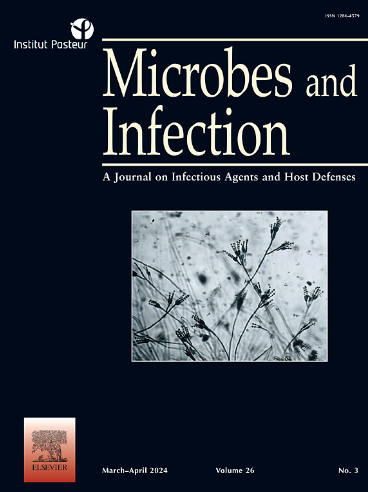Evolution and zoonotic risk of O1:K1 and O2:K1 avian pathogenic Escherichia coli
IF 2.7
4区 医学
Q3 IMMUNOLOGY
引用次数: 0
Abstract
The O1 and O2 serogroups of avian pathogenic E. coli (APEC) and human extraintestinal pathogenic E. coli (huExPEC) are closely related, but their evolutionary relationships need to be further elucidated. This study classified nineteen O1 and O2 APEC into rpoB sequence types (RSTs) and compared them with reference huExPEC using molecular prophage typing, virulence and antibiotic resistance gene profiling, and comparative genomics. Most O1:K1 and O2:K1 APEC (73.7 %) were classified as RST46-1 and RST47-9. RST47-9 is unique to Korean O1 APEC and likely derives from RST46-1 APEC. The six APEC showed high genome coverage/identity with the Korean RST46-1 huExPEC. Based on RST network and comparative genomics, we hypothesized that the O1 antigen first appeared in RST19-1 and O2 in RST24-1 E. coli in humans. Then, O1 and O2-antigen horizontally transferred to human RST46-1, where a unique K1 capsule (K1-cps) first appeared. The Korean APEC and huExPEC share evolutionary CRISPR spacers but differ in molecular antibiograms and prophage contents. Thus, RST46-1 huExPEC transmitted and evolved in poultry. The zoonotic risks remain unknown, but the substantial virulence of the RST46-1 APEC indicates that the reverse zoonotic risk of huExPEC in poultry is alarming.
禽致病性O1:K1和O2:K1大肠杆菌的进化和人畜共患风险。
禽致病性大肠杆菌(APEC)和人肠道外致病性大肠杆菌(huExPEC)的O1和O2血清群亲缘关系密切,但其进化关系有待进一步阐明。本研究将19个O1和O2 APEC分类为rpoB序列类型(rst),并利用分子噬菌体分型、毒力和抗生素耐药基因谱和比较基因组学将其与参考huExPEC进行比较。大多数O1:K1和O2:K1 APEC(73.7%)被归类为RST46-1和RST47-9。RST47-9是韩国版O1 APEC独有的,很有可能是由RST46-1 APEC演变而来。6个APEC与韩国RST46-1 huexp具有较高的基因组覆盖度/同源性。基于RST网络和比较基因组学,我们推测O1抗原最早出现在RST19-1中,O2最早出现在人类RST24-1大肠杆菌中。然后,将O1和o2抗原水平转移到人RST46-1,在那里首次出现了独特的K1胶囊(K1-cps)。韩国的APEC和huExPEC具有相同的进化CRISPR间隔序列,但在分子抗生素图谱和前噬菌体含量方面存在差异。因此,RST46-1禽流感病毒在家禽中传播和进化。人畜共患风险尚不清楚,但RST46-1 APEC的巨大毒力表明,禽流感病毒在家禽中的反向人畜共患风险令人担忧。
本文章由计算机程序翻译,如有差异,请以英文原文为准。
求助全文
约1分钟内获得全文
求助全文
来源期刊

Microbes and Infection
医学-病毒学
CiteScore
12.60
自引率
1.70%
发文量
90
审稿时长
40 days
期刊介绍:
Microbes and Infection publishes 10 peer-reviewed issues per year in all fields of infection and immunity, covering the different levels of host-microbe interactions, and in particular:
the molecular biology and cell biology of the crosstalk between hosts (human and model organisms) and microbes (viruses, bacteria, parasites and fungi), including molecular virulence and evasion mechanisms.
the immune response to infection, including pathogenesis and host susceptibility.
emerging human infectious diseases.
systems immunology.
molecular epidemiology/genetics of host pathogen interactions.
microbiota and host "interactions".
vaccine development, including novel strategies and adjuvants.
Clinical studies, accounts of clinical trials and biomarker studies in infectious diseases are within the scope of the journal.
Microbes and Infection publishes articles on human pathogens or pathogens of model systems. However, articles on other microbes can be published if they contribute to our understanding of basic mechanisms of host-pathogen interactions. Purely descriptive and preliminary studies are discouraged.
 求助内容:
求助内容: 应助结果提醒方式:
应助结果提醒方式:


